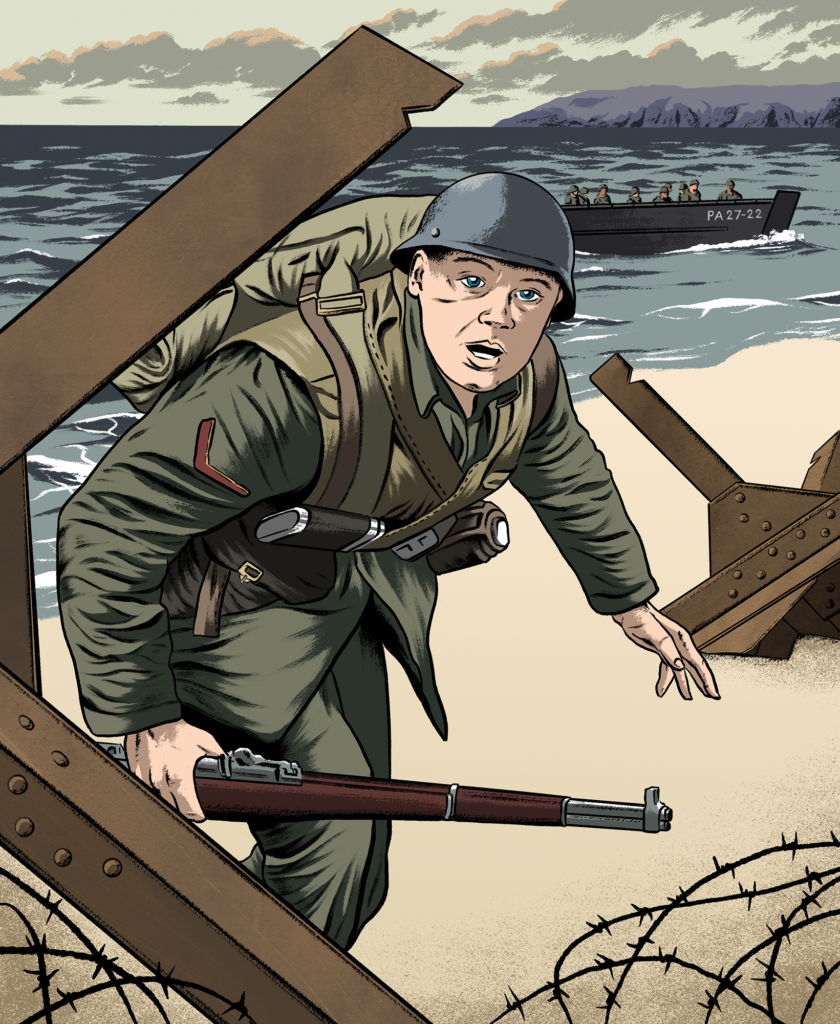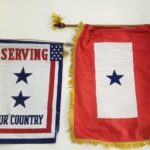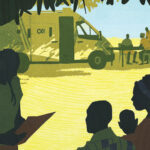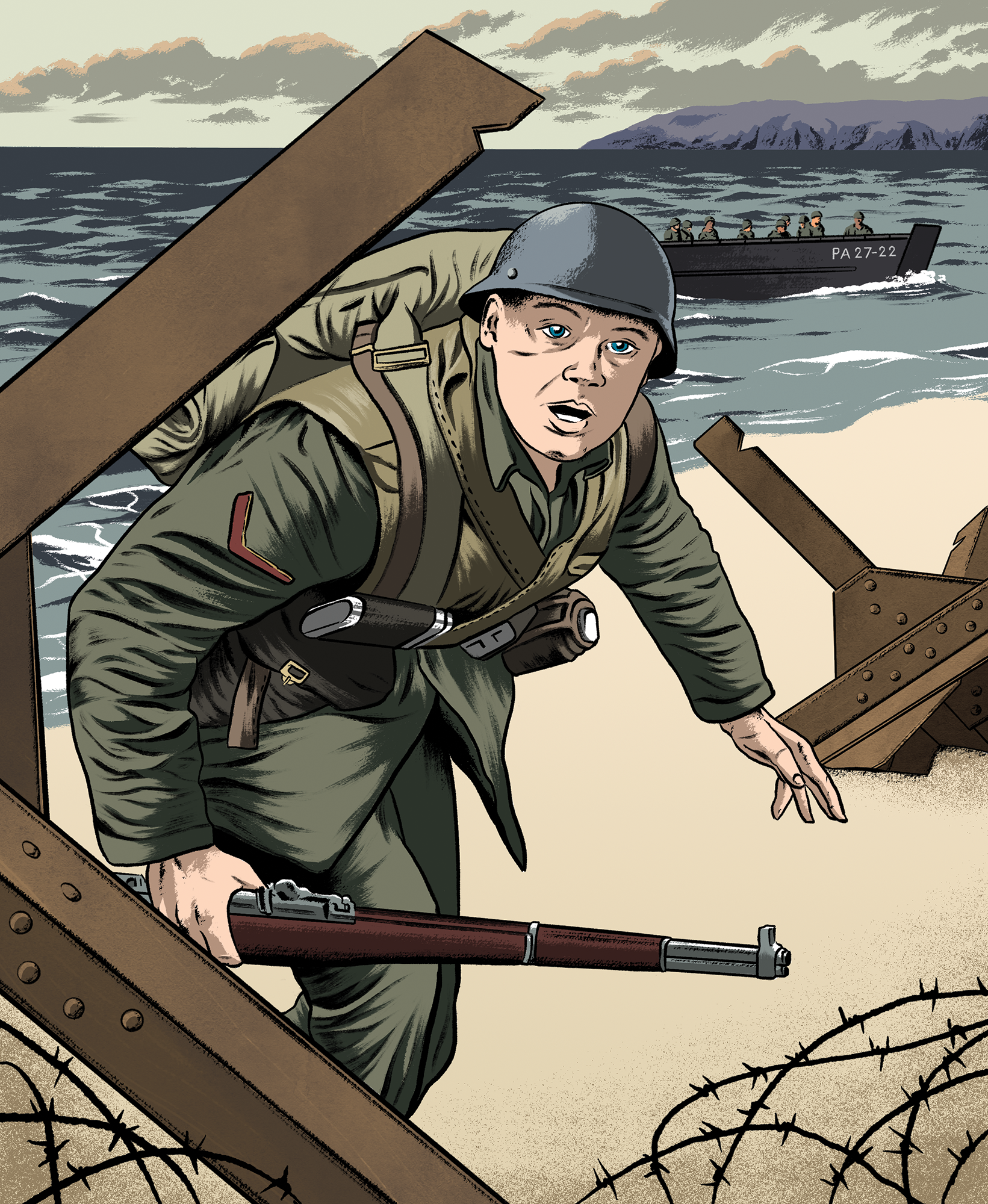As the tour bus drove toward Omaha Beach, Steve Hall scanned the coastline for a sign, motioning the driver to pull over when the telltale French bluffs came into view. They parked on the side of the road near one of the five sites where Operation Overlord—D-Day—occurred on June 6, 1944, nearly 80 years ago. Thousands of soldiers crossed the sands of Normandy that day, helping to save Europe from German invasion, and this spot was particularly significant. 
Hall called a puzzled passenger to the front of the bus, pointed at the sea, and said, “I’m positive your dad came ashore between there and there.” As a retired Air Force colonel and teacher in the U’s Continuing Education department, Hall relishes moments such as these, when the past comes alive. He had come to France a week before to make arrangements and figure out meaningful connections for his students, some of whom had close relatives who fought in D-Day.
As memory of the events that led to D-Day begin to fade, the lessons taught in Hall’s Osher Lifelong Learning Institute classes and Go Learn experiences are becoming even more significant. The monumental military operation was a turning point in World War II, rife with strategic and moral takeaways, but it also marked a collective stand of allies against tyranny—democracy over dictatorship. The hard-won battle against Nazism inspired a generation to vow “never again”—but as extremist sentiments and Holocaust denials increase, historians wonder if the past could repeat itself. At the U, history classes and library exhibits are keeping the memory alive—and so is Hall, every time he tells the story.
“We went down and stood on the beach just like [the soldiers] did,” Hall says of a recent Go Learn trip. “And this sounds corny, but I think the 4,413 souls of the people who died on the beach knew we were there.”
BATTLE STORIES
You might think Hall would retire after serving in the Air Force for 26 years and completing two other careers after that. But at 77 years old, he is happy to teach Continuing Ed—it’s more of a love affair than a job.
“I’m evangelical about telling the story and telling it right,” Hall says. “I think it’s unconscionable that important parts of American history just aren’t taught anymore.”
Hall thrills over the details of D-Day that can be overlooked. The massive military undertaking was in the works for two years before it happened, requiring the United Kingdom, Canada, and the U.S. to build and assemble a fleet of boats with flat bottoms just for this purpose. The initial plan was to launch the attack in May, but they were running behind—and running out of time. Each day, the Allied forces risked being discovered and the possibility that Germany would send more soldiers to the area.
A storm raged in early June, but a break in the clouds—unseen by Germany—gave the U.S. the element of surprise. At 6:30 a.m., the boats floated in and lowered their ramps at five beaches: Utah, Omaha, Gold, Juno, and Sword. Hall quizzes his students at a moment’s notice to check that they remember the names.
The first waves of soldiers who disembarked onto the beach were under heavy fire, and casualties were high. In the first two hours, 4,413 Allied soldiers were killed. The soldiers who survived changed their plans and scaled the bluffs instead of forging up the valley floor. By the end of the day, 156,000 soldiers had deployed onto the beaches.
“The plan went to hell in a handbasket almost instantaneously,” Hall says. “Instead of the guys on the beach saying, ‘What do we do now?’ They said, ‘OK, we’ve got to do something different.’ And that turned out to save the day.”
Hall believes the frontier spirit—an “act first, ask forgiveness later” attitude—allowed the Allies to succeed. The importance of being decisive while being flexible is a lesson that still applies today, he says.
“I use D-Day as an example all the time,” Hall says. “Make your decisions, make them fast, and if they don’t work, do something else.”
 HOLDING ON
HOLDING ON
Of the 16 million Americans who served in World War II, fewer than 200,000 are still alive. The war ended 77 years ago, and often, those who can answer questions and say, “I remember, I was there,” are in their 90s. Their stories are at risk of fading away if they are not preserved.
In the early 2000s, the American West Center in the College of Humanities embarked on a mission to capture those stories in a project called “Saving the Legacy: An Oral History of Utah's World War II Veterans.” As part of the project, the center has interviewed 433 veterans, filling nearly 600 tapes, which are held at the J. Willard Marriott Library. Veterans of subsequent wars have since been included as well.
“Their contribution was hugely important, and they deserve to be added to the history of our country,” says Liz Rogers BA’99, head of manuscript archives in Marriott Library’s Special Collections department.
Outside of the oral histories, the library has 510 listings of collections for World War II. Some of the items are documents from donors who gave personal papers from their war-time service, and others are memorabilia—including a field stove the size of a Thermos bottle, a flight jacket, and a Women Airforce Service Pilots (WASP) scrapbook. (See below for photos of some of the items.)
The library takes pains to preserve each item with acid-free bond paper, boxes, and folders.
“The main purpose of our division is to make sure that in one hundred years, the collections will still be a viable part of American culture,” notes Rogers. “It will not only be something you can read about; it will be touchable and useful.”
The collections are accessible and used by students at the U or nearby high schools, but occasionally reporters, filmmakers and other media outlets ask to use the material. Some of Rogers’ favorite patrons are veterans’ descendants who come to do research on their family members.
“The purpose of all libraries is to not only retain knowledge in different forms, but to also make knowledge available to all who want it,” Rogers says.
 NEXT GENERATION
NEXT GENERATION
Julie Ault takes comfort in seeing the numbers of students who enroll in her “Age of Total War” and “Nazi Germany and the Holocaust” classes. As an associate professor of German and European history at the U, she knows her material can seem bleak and foreign to this new generation, but still, they sign up.
“Even if they did not have grandparents or great-grandparents who served in the war, students are very much interested,” Ault says.
It just so happens that Ault’s own grandfather was at D-Day as a war correspondent who came onto the beach in one of the last waves, wading through the water with his typewriter over his head. She sometimes thinks of him when she receives letters from those who say the Holocaust didn’t really happen or wasn’t as bad as it sounds.
“It is not an accident that we’re seeing a rise in violence now as living memory of World War II disappears,” Ault remarks. “The societal knowledge of what violence and war can bring on society is lessening, and that taboo of violence is fading away.”
The impact of World War II on Europe was devastating and long-lasting. At the end of the war, there was no independent Germany for four years—it was divided into four zones of occupation and became the front line of the Cold War. Wholescale death and cataclysmic disruption of life impacted tens of millions of people, with entire cohorts of society who died. It took the Soviet Union until the 1960s to have equal numbers of men and women again. After bombings across Europe destroyed a massive number of homes, it took years to rebuild housing stock across the continent.
The course that led to such devastation began with economic hardship around the world in the 1930s. Fascism and communism grew in popularity in response to the Great Depression and resultant deprivation, and people craved action, seeing democracy as weak. When the U.S. disembarked on the shores of France as part of D-Day, it wasn’t to occupy a territory or take power—it was to defend a sense of ideals, to preserve freedom, and to eschew the disregard of human life, Ault says.
Although time is pressing forward, the lessons of D-Day don’t have to fade away, Ault adds. The stories of history and those who’ve gone before can remain in books, in libraries, and in the classroom.
“I think, more generally, history is really important because it teaches us that we can do better,” Ault says. “We can learn from the past, build solutions, and make things better.”
About the author: Amy Choate-Nielsen is the PR and Communications manager for the Office of Academic Affairs.
Saving the Legacy
The first-person accounts of the men and women involved in World War II are simultaneously fascinating, sobering, and inspiring. Here are excerpts from recorded oral histories in the Saving the Legacy project.
Allen R. Ervin
Roy, Utah
Fought on D-Day at Omaha Beach in Normandy
“When you’re in a war, war is going on 360 degrees all around. You can only see one degree. You don’t know what was going on anywhere else, just where you were. So, everybody’s experience is different.… If I had to do it all over again, yes, I would. If I knew I was going in, in the first wave, yes, I would. Things have changed.… It was a different time. It was a time of unity.”
Sophia Howard
Salt Lake City
A Holland native liberated by Allied forces
“You see it in the war movies that you see sometimes. It was really that. I remember real well… when we got liberated. Oh, that was so much fun. They came in on tanks. We climbed up on those things. We were so happy. I remember they had big containers full of crackers. And they kind of distributed that to us. We were really pretty hungry then, because we hardly didn’t have any food anymore. We didn’t have any heat. I sometimes think, oh, how did we ever survive? It’s amazing—when you have to do it, you do it. That’s all there is to it, really, because there is no other way, and somehow, we survived.”
Adelia “Dee” Hall Rushforth
Fruit Heights, Utah
A U alum (1941) who joined Women Accepted for Volunteer Emergency Service (WAVES) in the Navy
“They were pleading for women to go work in the offices so the men could go to war and fight the actual battles. We were very patriotic in our day. We loved our country, and we wanted it safe, so we did everything we could. That was a good thing or we wouldn’t be here.… When we think about these other wars, they don’t seem like real wars to me. This was a real war. This is the war where every one of your brothers and your father, if he was young enough, all your friends, all of them went to war and a lot of them didn’t come back.”
John A. Lindquist
Ogden, Utah
Utah native who flew a mission during D-Day
“We went operational on D-Day, the first combat mission we flew. We started out on the second flight of D-Day and our target was an artillery bunker, a big concrete building that overlooked Utah Beach on Normandy. We didn’t drop our bombs that day because we couldn’t find our target and you were not allowed to circle and look for it; you had to go in with one minute plus or minus of your designated time and bomb your target and get out. … The weather was terrible. It was cloudy and rainy and we simply couldn’t find our targets so we had to fly across the Cherbourg Peninsula, out across the Bay of Biscaye, drop our bombs in the ocean and then head back to England, making landfall at Plymouth.”
Keith Davis
Springville, Utah
Was part of the liberating army
“After Koblenz we went into Germany. This concentration camp Ohrdruf, Germany, is by the town Ohrdruf. When we went in, they had machine-gunned all they could before they ran away, but there were still lots of people still alive there. These people were so thin they did not even bleed. When the people saw us, they were frightened of the Americans. The prisoners were afraid because we had uniforms on, and they thought they were in for more trouble like they had already had. Soon they found out we weren't there to harm them.”
Malcolm J. MacGregor
Park City, Utah
His plane was shot down over Germany and he became prisoner of war
“When we were taking our rest, out of one of the buildings came this nice lady that would have been about my mother's age at the time, maybe 50, and she had a tray, a big tray with glasses and a pitcher of water. She came out to give us a drink. That was the kindest thing that I saw in Germany, even in the middle of a war. It made me realize that there were guys that would beat you, guys who would kick you and somebody that would give you a drink of water and they were all Germans. I didn't think then that all Germans were monsters. That was a nice lady.”
WWII Memorabilia Photo Gallery








I think people born in the 70s, 80s, 90s, and 2000s have no real understanding of the sacrifice and commitment that winning WWII was for my parent’s generation. Many younger people have no idea how many people died in WWII. The more that can be done to educate people on this war, the better off we will all be.
Thank you for this wonderful, amazing and priceless effort the U of Utah and its staff have undertaken to preserve and make available the stories of the individuals who lived and served in WWII, specifically D-Day. I am a 24-year veteran (USAF – did ROTC at the U). We just toured thru the D-Day area this last month. Going and walking the beaches, thru the cemeteries in the Normandy area, the various museums and monuments, is a truly poignant and powerful experience. We have also been to two of the more infamous concentration camps –Dachau and Sachsenhausen– and I have met several survivors of those horrible places. Many of my grandfather’s (Lawrence Edward “Buss” Stringham) brothers served in WWII (he was older, had a family and served in the Army in the early 1930s .. and was working at Kennecott Mine so the military said “No .. stay and work here). Some were wounded in action in the US Army and Navy, both; I remember my great-Uncle Carl using a cane and struggling to walk due to his wounds. How anyone can deny or even minimize the actions of the fascist regimes in the world of the 1930-40s … is unimaginable? In my service in the USAF, I was privileged to go many places and see much of the areas where WWII (and some WWI) happened such as Okinawa Japan, the Philippines, the Aleutian Islands in Alaska, England, France, Greece. I am writing this from Prague, Czech Republic … where I have just seen the bullet holes in the columns of the National Museum which came during the brutal crackdown by the Soviet Union Red Army in the Prague Spring of 1968. I remember hearing of that event listening to our car radio while it was happening and the sadness of my parents; i was 9-years old at the time. There are far too many reminders of man’s inhumanity to man … and yet … there are not enough! Every human being needs to truly practice, above all else, the Golden Rule of doing unto others (treating others) in the manner you wish to be treated. BTW, we currently live in Stuttgart, Germany.
With Great Appreciation for this –and all the other great information the U Magazine provides me regularly.
Stephan Stringham
U of Utah Class of 1983
Stephan, thank you for sharing these powerful stories!